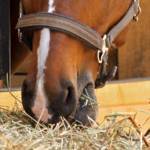Five Reasons to Analyze Horse Forage and Pasture

That hay you just paid a small fortune for smells sweet, seems to have an ideal stem to leaf ratio, a minimum number of weeds, no obvious blister beetles, and doesn’t seem dusty or moldy. What else do you need to know?
According to equine nutritionists and laminitis researchers*, there is a lot more we can learn about the forages we feed our horses to optimize health, prevent disease, and promote self-healing.
“Hay analysis does a lot more than just identify the percent of water-soluble carbohydrates in a particular batch of hay bales,” concurs Kathleen Crandell, Ph.D., nutritionist at Kentucky Equine Research.
Considering these compelling reasons to have your hay and pasture analyzed:
1. Testing will tell you if your horse will receive adequate levels of energy (calories).
2. Analysis can measure individual nutrients and help determine if there are any dietary deficiencies that need to be addressed. Trace minerals such as copper and zinc are known to be deficient in forages harvested from various regions throughout the United States, including the Pacific Northwest.
“Not only are adequate levels of trace minerals important but also the ratio of those minerals,” advises Crandell.
3. Protein levels can be also be determined to ensure there is not too much (which can be detrimental to the performance of the athletic horse) or too little (resulting in poor growth in young animals, poor hoof and coats, loss of muscle, etc.).
4. The digestibility and palatability of the hay can be assessed.
5. And of course, the sugar and starch content, which is important for horses with insulin resistance, equine metabolic syndrome, or those that are overweight.
Hay analysis is widely available, relatively inexpensive, and is currently the most scientifically valid method of ensuring a balanced diet is being offered to your horse. Contact a certified equine nutritionist or your local equine extension specialist for assistance and information on sampling techniques.
*Smithey, J., and K. Gustafson. 2013. Nutrition complexities and mineral profiles of hay. In: Proceedings of the 2013 NO Laminitis! Conference.








